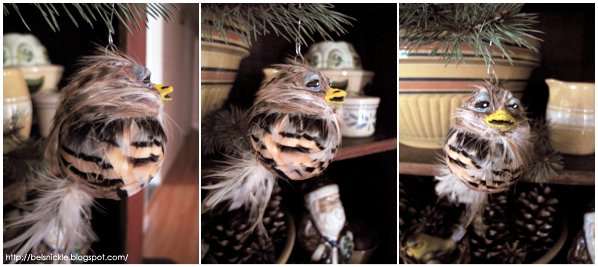To hand sculpt a cotton batting animal, such as this handsome little buck below, may seem a bit too ambitious at first. However, if you can dig a few plastic figures out of your child's toy box, to look at as you work, you may surprise yourself with the finished result!
Hold the small plastic animal in the palm of your hand and explore it's surface with your fingers; study it's shape carefully. By doing this, you are giving important tactile information to your brain. If you have never sculpted anything before, you must ask your eyes, hands, and mind to think about how shapes feel and look in three dimensional space over and over again.
Sculpting with any medium, whether it be clay, paper pulp, fabric or cotton is a tactile process. You can make many simple things but you must train yourself to be a keen observer with your hands as well as with your eyes!
I've also included video links below to help guide you through the beginning processes of sculpting with both clay and paper. In sculpting, beginning concepts are the same no matter what medium you chose to manipulate.
 |
| Close up photo of my deer's face. |
Supply List
- cotton balls
- white school glue
- chenille stems
- newsprint
- tacky white glue
- small soft paint brush (for painting)
- acrylic paints: browns, black, white
- bit of white fur or soft milk weed floss
- wire for hanging
Step-by-Step Instructions:
- Shape a small piece of newsprint into the torso and extended head of the deer. Masking it with tape as you compress the paper into an approximate shape.
- Bend chenille stems into antler and leg shapes. Use tacky glue and masking tape to attach these parts to your crushed newsprint torso and head.
- Let the glue dry.
- At this point you need to shape a small wire loop and attach it with glue or tape to the backside of your deer. The majority of this wire will be covered from view by tape, glue and cotton. However, you need to leave a small piece of this wire exposed so that deer may be properly hung from the tree.
- Now wrap masking tape around the entire body.
- Unravel several cotton balls at a time and cover the surface of your deer with white glue and cotton batting layers several times. Always end a step in this process with a final coat of white glue. I spread this with my finger tips as I go.
- Work in a warm, dry area so that parts of your deer will dry before others areas are completed. Anticipate that you will need several days to complete the whole process. Wrapping cotton batting figures is not a speedy craft.
- I rolled small bits of cotton between my finger tips to shape this deer's eyes, nose and ears. I shaped his mussel with a toothpick dipped in white glue.
- I have included detailed photos of the finished deer prior to painting him with neutral-toned brown acrylic paints. Study these photos closely.
- After painting my deer, I then glued milkweed floss to his under belly, his tail and inside his ears. You may use any furry stuff that you have on hand to finish off these little details.
- Wrap and shape a cotton batting wire hook for hanging the deer with.
 |
| Masking the deer. Both his antlers and legs are shaped from chenille stems. |
 |
| Wrapping the deer with cotton batting, multiple views. |
 |
| The painted, finished cotton batting deer. His fuzzy tail, belly and inside ears are made from milk weed floss. |
The Basics of Sculpting: Start With Basic Shapes:
- Learn Sculpting - Lesson 1 - Clay Modeling This video will help you to get ideas and concepts about basic shapes, how these fit together etc...
- How to sculpt with paper: This video shows how to build a paper shape like the process I used above. Except, I exclude the wire armature when crafting light weight figures for the Christmas tree. It is unnecessary to include intricate internal armatures for very small figures. Also this video depicts a finishing step that is not often used with cotton batting figures, the additional step of applying paper mache pulp.


















































